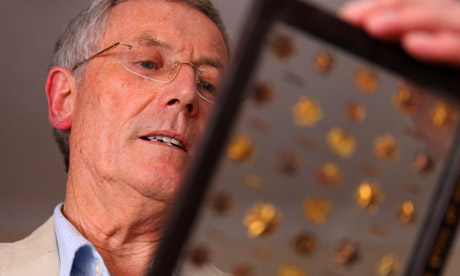
The bones of Lord Buddha have been discovered under a mound in Northern India. So why isn't everyone excited? Noted historian Charles Allen explains why
In 1898 Colonial estate manager Willie Peppe's workers, digging at a mysterious hill in Northern India, found what seemed to be the most extraordinary discovery in Indian archaeology. 20 feet down they unearthed a huge stone coffer containing 5 ancient soapstone jars, over 1600 separate jewels and some bones. And one jar had an inscription that appeared to say they were the remains of the Buddha himself buried by his own 'clan', the Sakyas.
Sadly, the involvement of Dr Anton Führer, a shadowy German archaeologist subsequently exposed as a fake and a fraud, has cast doubt and scandal over this amazing find. For over 100 years it has been ignored and avoided.
In a new film, The Bones of the Buddha, renowned historian Charles Allen sets out to solve the mystery once and for all.
Allen was initially drawn to the project through his interest in the ‘orientalists’ of the British period in India, the men who rediscovered India’s history through things like coins, inscriptions and finding old manuscripts.
“They've always been my heroes in a lot of ways,” he says . “Guys like William Smith, the father of Indian studies, and in particular, James Principe, the guy who sits down and actually beaks the code of this strange and mysterious language.”
That language is Brahmi, devised by Emperor Ashoka, and India’s first written language. It is also the language found inscribed on a vase found at the Piprahwa excavation, the authenticity of which is the key to solving the mystery. The inscription dates the vase to the time of Emperor Ashoka and confirms Allen’s theory that the Sakya clan’s portion of the original remains of the Buddha were dug up by Ashoka, divided even further and then reburied with jewels.
The key to the program was convincing one of the world’s leading epigraphists, Professor Harry Falk, to travel to India to study the inscription and validate it’s authenticity. Professor Falk had largely ignored the Pripahwa discovery because of the controversy but was genuinely excited by what he found.
“And as you’ll see in the film, he has no doubts about it," says Allen. "He says that it is quite patently genuine and he explains why. There’s a word used for remains, that has not been used anywhere else.”
Professor Falk was also able to confirm that the coffer was also from the Ashokan period.
“He measured it, examined it and confirmed it as an Ashokan artifact,” explains Allen. It conformed to Ashokan yard, the measurement introduced by Emperor Ashoka, and displayed exceptionally high quality craftsmanship.”
“More excitingly, Professor Falk discovered little black spots in this pink sandstone that confirmed it came from the same quarry as the Lumbini column, erected by Ashoka, came from.”
The Indian authorities, however, seem less convinced, leaving these important relics neglected. The vase with the inscription is kept in a metal cabinet in the back of a dusty office. The giant stone coffer sits in a courtyard in the museum in Calcutta, mislabelled and left out in the elements.
“The help we got from the Archaeological Survey in India and the museum was minimal.’ Says Allen. “They were just very, very unwilling to help. It took six weeks of negotiation to get them to open up and show the vase with the inscriptions.”
His request to see the jewels that were discovered with the remains was met with a curt refusal.
I asked Allen why he felt there was such apathy towards such a potentially monumental find and he readily admits that it is the involvement of Dr Führer tainted them, despite the fact that he has “a whole series of letters “ that indicate that say Führer never visited the site until six weeks after the excavation.
It doesn't help, either, that one of the world’s experts on Buddhist relics, Dr Michael Willis from the British Museum, is not convinced of the find’s authenticity. Allen says that he asked Dr Willis to take part in the program but he refused because it was “too hot to handle.”
Allen says that Doctor Willis is yet to be convinced that the inscription is genuine.
“It’s maddening,’ explains Allen. “It’s not just Professor Harry Falk who has said it was genuine, but the other great Sanskritist of our era, Professor Richard Salomon of the University of Seattle has also said that there is no question that it is anything part genuine.”
After decades of research, Allen hopes that this film will finally lay the myth to rest and finally remove the stain of impropriety from this important excavation.
“It’s just thrilling to be able to bring this story to a conclusion after ten years,’ he says. ‘And thrilling that to have a great, world leading authority like Professor Harry Falk say that it’s genuine.”
The Bones of the Buddha was produced by Icon Films and will air on National Geographic UK on May 11th, 2013 at 8pm.